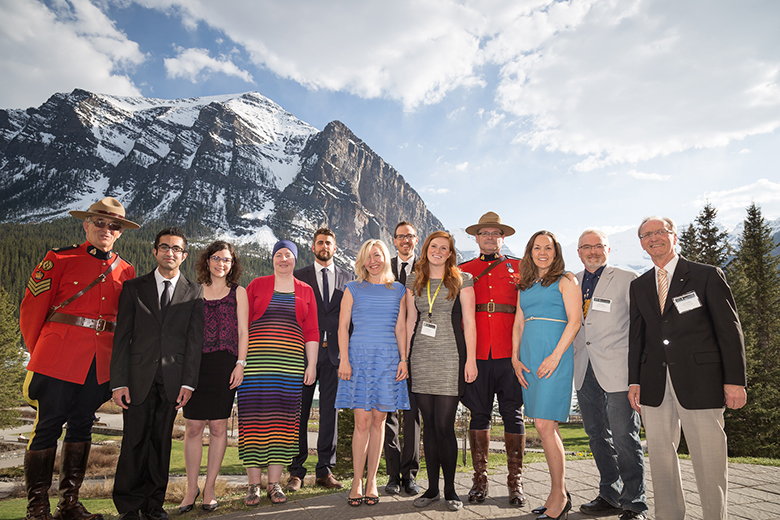
Delegates of OSSEO 2015, including members from the Institute for Reconstructive Sciences in Medicine and University of Alberta, stand with a pair of local Mounties at Lake Louise. (Photo: Matthew Clark)
(Edmonton) Scientists, engineers and hearing-related professionals from 27 countries around the world converged on Lake Louise, Alberta to take in some picturesque Rocky Mountain scenery and share the latest advances in bone conduction hearing research and technology.
"Beethoven would clench a wooden dowelling in his teeth and put the other end on his piano's soundboard to hear his music," explains Bill Hodgetts, an associate professor in the Faculty of Rehabilitation Medicine. "That's the first good example of bone conduction at work."
In addition to his post with the University of Alberta, Hodgetts holds a joint appointment with the Institute for Reconstructive Sciences in Medicine (iRSM) where he is program director for Bone Conduction Amplification.
It was this combination of academic and clinical experience that positioned Hodgetts to be asked to take on the challenge of hosting the conference, known officially as the Fifth International Symposium on Bone Conduction Hearing And Related Technologies (Osseo2015).
"It was an exciting challenge. The site that we chose, the weather we had, the program we put on, everything was really positive-Alberta at its best for our international visitors," says Hodgetts.
Rapid growth in a field that is less than 40 years old means constant progress in technology, measurement methods and patient assessment.
"This was a huge conference for a field that has gone from obscurity to being mainstream almost overnight," says Hodgetts. "I think everyone who attended discovered something new and innovative to take home."
Alberta a leader in hearing implant research
Studies at the U of A, combined with clinical and research applications at the iRSM have put us on par with the biggest centres for bone conduction in the world, says Hodgetts.
"We understand how to fit and verify these devices. Algorithms developed at the U of A give us a good understanding of what the patient needs in terms of output before we even have the device. This ensures a more accurate, individualized fitting and saves time for the audiologists and patients.
"It's the difference between buying a suit off the rack and having a suit tailored to you. It's one of the things we are doing well here in Edmonton, maybe better than anywhere else."
For the 370,000 Albertans with hearing loss, there are 143 audiologists, or hearing-health specialists, all of whom are trained out of province. It's a situation that does not bode well for the increasing numbers of aging Albertans losing their hearing, Hodgetts says.
"Alberta is very close to being ready, but we lack enough hearing services. Audiologists provide those services, but there are not enough audiologists to support the growing numbers."
Research links significant hearing loss in older adults with impaired memory, depression and onset of dementia. Alberta Seniors projects that in 15 years one out of five Albertans will be 65 or older, nearly a third of whom will suffer from hearing loss.
Albertans wanting to study audiology have a choice of three English-language programs in Canada. Hodgetts wants there to be a fourth, right here in Alberta.
"The Faculty of Rehabilitation Medicine has a strong speech language pathology program. We have an excellent record of collaborating with medical institutes to ensure our students have professional as well as academic skills. There is no reason why we should not provide the answer to our own problems."
Promising future for hearing in Edmonton
Bone conduction has become mainstream with Google Glasses, goggles for swimmers and communication devices for first responders who need their ears open for sounds in their environment. But when it comes to implanted hearing technology, Edmonton has a bright future.
"Members in the field here are both researchers and clinicians. That means as well as doing the hard research at the U of A, we also work closely with patients. That close integration pays off. In my ideal future, all Albertans will have greater access to hearing care services and we will continue to be looked upon as a world-leader in implantable hearing."